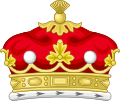This article includes a list of general references, but it lacks sufficient corresponding inline citations .(January 2015) |
| Marquessate of Normanby | |
|---|---|
  Quarterly: 1st & 4th, Sable, a Trefoil slipped between eight Mullets Argent(Phipps); 2nd, Paly of six Argent and Azure, a Bend Gules(Annesley); 3rd, The Royal Arms of King James II within a Bordure compony Argent and Azure(by grant from King James II to his natural daughter, Lady Catherine Darnley) | |
| Creation date | 25 June 1838 |
| Creation | Second |
| Created by | Queen Victoria |
| First holder | Constantine Phipps, 2nd Earl of Mulgrave |
| Present holder | Constantine Phipps, 5th Marquess of Normanby |
| Heir apparent | John Phipps, Earl of Mulgrave |
| Subsidiary titles | Earl of Mulgrave Viscount Normanby Baron Mulgrave (GB, 1794) Baron Mulgrave (I, 1767) |
| Status | Extant |
| Seat | Mulgrave Castle |
| Motto | Virtute quies ("Rest in virtue") |
| For the 1st creation of the Marquess of Normanby see Duke of Buckingham and Normanby | |

Marquess of Normanby is a title that has been created twice, once in the Peerage of England and once in the Peerage of the United Kingdom. The first creation came in 1694 in the Peerage of England in favour of John Sheffield, 3rd Earl of Mulgrave. He was a notable Tory politician of the late Stuart period, who served under Queen Anne as Lord Privy Seal and Lord President of the Council. In 1703 this first Marquess of Normanby was further honoured when he was made Duke of Buckingham and Normanby. These titles became extinct on the death of the 2nd Duke in 1735.
Contents
- Marquess of Normanby, First creation (1694)
- Barons Mulgrave, First Creation (1767)
- Earls of Mulgrave, Second Creation (1812)
- Marquesses of Normanby, Second Creation (1838)
- Family tree
- Line of succession
- See also
- References
- Sources
The second creation came in the Peerage of the United Kingdom on 25 June 1838, in favour of Constantine Phipps, 2nd Earl of Mulgrave. He was a noted politician and served as Lord Lieutenant of Ireland and as Home Secretary. His great-grandfather William Phipps had married Lady Catherine Annesley, who was the daughter and heiress of James Annesley, 3rd Earl of Anglesey and his wife Lady Catherine Darnley (an illegitimate daughter of King James II by his mistress Catherine Sedley, Countess of Dorchester). Lady Catherine Darnley had later married John Sheffield, 1st Duke of Buckingham and Normanby, and hence Constantine Phipps, 2nd Earl of Mulgrave was the step-great-great-grandson of the 1st Duke of Buckingham and Normanby. Upon his death, Constantine Phipps, 1st Marquess of Normanby was succeeded by his son, the 2nd Marquess. He was a Liberal politician and also served as Governor of New Zealand. His grandson, the fourth Marquess, served briefly as a Labour Lord-in-waiting (government whip in the House of Lords) in 1945 and was also Lord Lieutenant of the North Riding of Yorkshire and of North Yorkshire. As of 2013 the titles are held by the latter's eldest son, the fifth Marquess, who succeeded in 1994. The fifth Marquess also served in the House of Lords until he lost his seat in the House of Lords Act 1999.
The family seat is Mulgrave Castle near Whitby, North Yorkshire.
